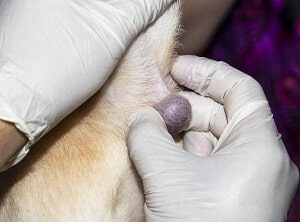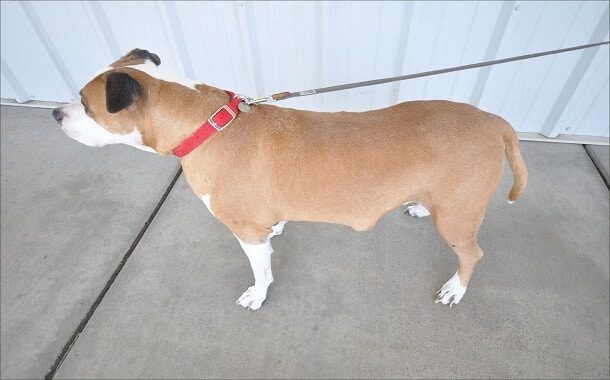Dog Lipoma Removal Cost
Last Updated on September 24, 2021
Written by CPA Alec Pow | Content Reviewed by ![]() CFA Alexander Popinker
CFA Alexander Popinker
It is not uncommon to find lumps and swellings in dogs. Growths and masses can occur in dogs at any age but are among the most common health problems seen in older dogs. It is very important to understand the different types of outgrowths you may encounter as a dog owner. Any persistent, unusual mass or lump should mean a call to the veterinarian.
A canine lipoma is an increase in fat cells contained in a thin capsule, which is usually found just under the skin.
Lipomas are most often found on the body, neck, legs, and armpits but can occur almost anywhere. They are the most common non-cancerous growths of soft tissues.
Dog lipoma removal surgery cost
As the cost of removing a dog lipoma will significantly depend on many different factors, it may be challenging to give an accurate estimation. These include: what surgical method is chosen, how big or small is your dog’s prospective surgery, where are you located in relation to veterinary clinics and hospitals that could perform such work, and whether or not there is any possibility that this procedure might require general anesthesia which would add substantially onto the final price.
You may pay around $40 to $80 for diagnosing the lipoma through a fine-needle aspiration. Most vets recommend no treatment as long as it isn’t affecting your dog’s quality of life or health in other ways. There are cases when a more complex investigation is necessary so more tests would be requested such as ultrasound and/or computed tomography and a radiograph.
You might also like our articles about the cost of dog tumor removal, dog anesthesia, or dog x-Ray.
The total price of removing a dog lipoma with all the tests included is somewhere between $270 and $700. But there are rare cases when the cost is more than $1,000 because of the lipoma being located in hard to access or complex areas. It must be said that the lipoma must be removed only if it affects your dog’s mobility.
According to Dr. Smith’s post on JustAnswer.com, you may have to pay $360 to $680 for the surgical procedure and the price for removing a dog lipoma is dependent on the dog’s age, health condition, size, and where it is located.
What are the extra costs?
Pain management is an essential consideration for any surgery, especially veterinary. Often, your vet will prescribe pain medication and anti-inflammatory drugs. They may also suggest wearing an Elizabethan collar if needed, which helps limit movement around their neck area during recovery time so they can heal properly.
The most common causes of lipoma in dogs are:
Poor diet
Carbohydrates, chemical preservatives, and other toxins found in processed foods contribute to the growth of fatty tumors. Water is also an essential part of your dog’s diet. As it gets older, tap water should be avoided, as chlorine can damage your dog’s thyroid and disrupt his endocrine system.
Chemical products
Products used f0r dogs to control fleas, ticks, or worms are not only toxic to insects and parasites, but also to your dog. There are natural and effective ways to control these internal pests without toxic residues. Talk to your veterinarian about the importance of vaccination and the steps to follow to prevent this.
Environment
Your dog’s environment is a significant source of toxins, especially if herbicides or pesticides are used in the area. When walking your dog in parks or places where herbicides and pesticides are likely to be used, wash your dog’s feet with water and veterinary shampoo when you get home to prevent him from licking or absorbing toxins by licking his paws.
Diagnosis of lipomas in dogs
 Your veterinarian may recommend the following diagnostic tests:
Your veterinarian may recommend the following diagnostic tests:
Fine needle aspiration. This easy diagnostic test involves the insertion of a needle attached to a syringe inside the lipoma and the withdrawal of a sample of cells. The contents of the needle and syringe are then placed onto a glass slide for analysis.
Cytology. The slides are evaluated microscopically for the evidence of fat cells (fats).
Biopsy. If there is no conclusive evidence of aspiration, a biopsy (tissue sample) may be taken. If the lipoma is small, an excisional biopsy can be done, which is a biopsy where the entire lipoma is removed. Biopsies usually require sedation with local anesthesia or general anesthesia.
Treatment of lipomas in dogs
If a lipoma is small and slow-growing, your veterinarian may advise an owner to observe the lipoma for any changes. If there are no significant changes, treatment is not necessary. In other cases, the following treatments are available:
Excision (removal) of a lipoma should be considered if it grows rapidly, causing discomfort or interfering with the mobility or lifestyle of the animal.
Infiltrative lipomas should be treated aggressively with extensive surgical excision. The excision will be incomplete most of the time because some of the tumor cells will remain on the body. If the remaining tumor returns slowly, this may be all the necessary treatment.
Radiation therapy is available if the lipoma is invasive and cannot be removed entirely.
Dog care at home
After a lipoma has been removed, be sure to periodically check the incision for any swelling, redness, or discharge. Make sure your pet does not lick or chew the incision line. The sutures are generally removed in 7-10 days.
After lipomas are spotted, they should be closely monitored. Lipomas should not be allowed to become so large that they are difficult to remove.


Leave a Reply
Want to join the discussion?Feel free to contribute!